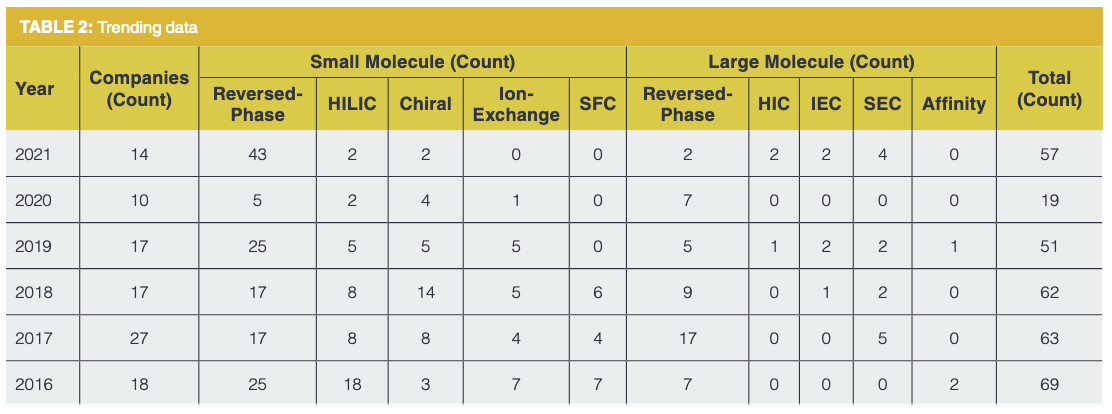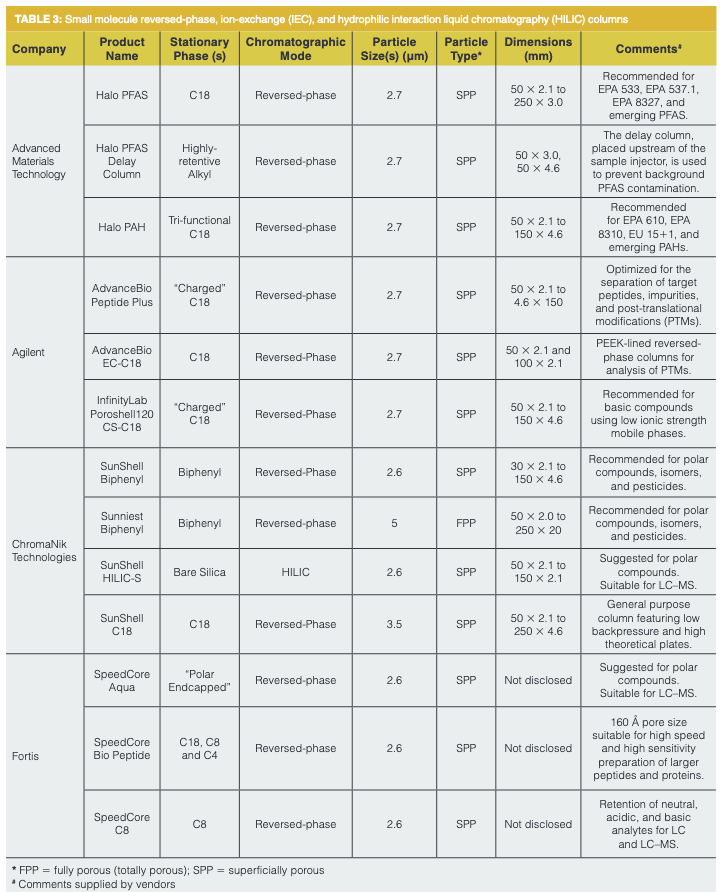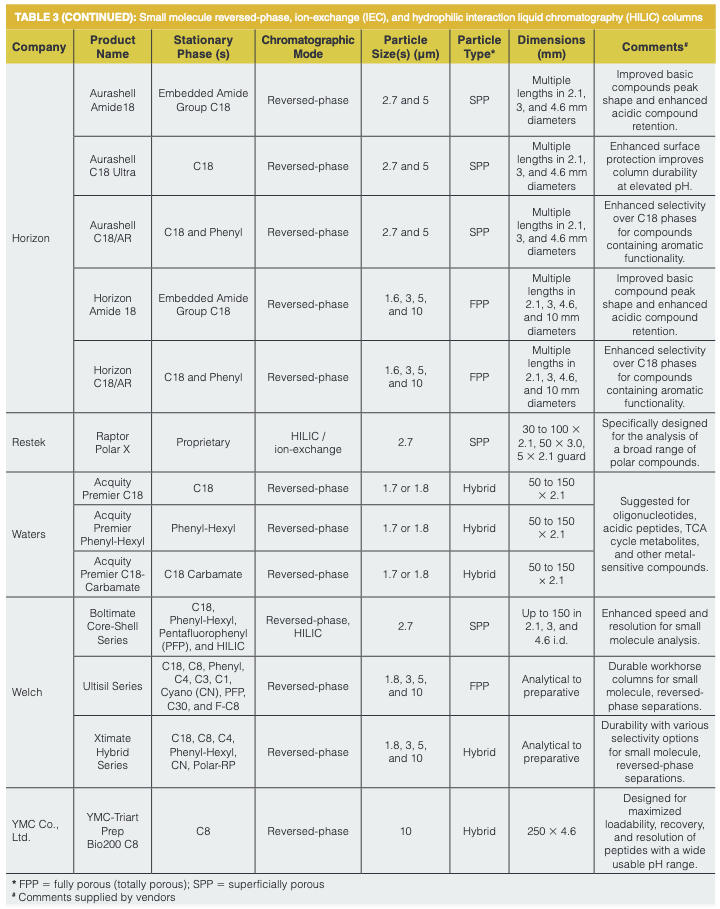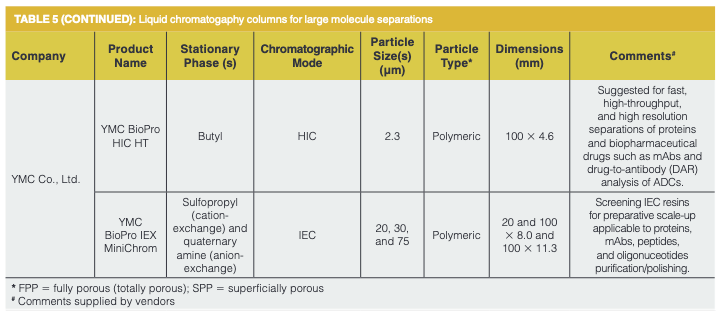New Liquid Chromatography (LC) Columns and Accessories for 2021
Our annual review of new liquid chromatography columns and accessories, introduced at Pittcon and other events over the past 12 months.
As in previous years, LCGC sent out a survey in late 2020 and early 2021 asking vendors to supply information on liquid chromatography (LC) columns and accessories launched after Pittcon 2020. Information for this article was obtained over the course of several months, and thus, it is possible that some information has been missed or misinterpreted. The reader is encouraged to check with specific vendor sites for additional products, as well as more detailed information on product usage and attributes.
The vendors that responded to the survey and their new LC products are listed in Table 1. The products vary in targeted analyte type, as well as in their mode of chromatographic operation. The columns can be initially categorized as addressing small molecule or large molecule challenges. Within these categories, the products can be further separated based on specific modes of separation employed, including reversed‑phase LC, hydrophilic interaction liquid chromatography (HILIC), hydrophobic interaction chromatography (HIC), size-exclusion chromatography (SEC), and ion-exchange chromatography (IEC). Chiral columns are treated as a separate category. In addition to new chromatographic columns, accessories related to LC are also addressed. Trends noted throughout the article are based on comparisons to yearly reports since 2016 (1–5).

In the 2020 LC product review, the number of vendors reporting new products as well as the overall number of products showed a sharp downturn over previous years. Table 2 provides a breakdown of products introduced in various categories over the previous five years plus this most recent year. The data suggests that the low numbers observed in the 2020 review was an anomaly, and not the beginning of a downward trend. The number of reporting vendors in 2021 is still low relative to some recent years; however, the number of unique column chemistries released is back on par with the previous five years of data. Please note that many products can be categorized in multiple areas, depending on usage. This is meant to be a basic guide that highlights trends only. Columns targeting reversed-phase analysis of small molecules represent the largest group of newcomers (columns ascribed for peptide and oligonucleotide analysis were grouped with the small molecule columns). Characterization of large molecules often requires the use of multiple modes of separation. The new columns launched over the past year for the analysis of large molecules targeting reversed-phase, SEC, HIC, and IEC reflect that need.

Small Molecule
Reversed-Phase/HILIC: The product offerings assigned to the small molecule category intended for reversed-phase and HILIC are listed in Table 3. A total of 45 new column chemistries are shown with 43 reversed-phase columns, representing the largest single category in this review. It is clear from the list that superficially porous particles (SPPs) remain a substrate of choice to build phases upon while additional surface chemistries continue to be developed on fully porous particles (FPPs) as well. Continuing trends of recent years, “extended” C18 phases highlight the list where the C18 attributes are enhanced through additional interactions via “polar endcapping”, charged‑surface modifications, or through co‑bonding with other functionalities. Columns specific to HILIC continue to show less activity in comparison to reversed‑phase developments.


Advanced Materials Technologies (AMT) released two phases targeting specific classes of compounds. Halo PAH (polycyclic aromatic hydrocarbons), built on SPP, is described as a tri-functional C18 suggested for use in methods such as EPA 610, EPA 8310+2, and EU 15+1. AMT also launched Halo PFAS (perfluoroalkyl substances), a column suggested for EPA 533, EPA 537.1, and EPA 8327. This latter column is an endcapped octadecylsilane (ODS, C18) also bonded to an SPP support. AMT notes that both columns are “application-assured” through method qualified lot analysis. To complement the PFAS column, AMT has also developed the Halo PFAS Delay Column, which is described as a highly retentive alkyl phase. The delay column, placed upstream of the sample injector, acts to prevent background PFAS contamination from interfering with the PFAS analytes of interest.
Agilent introduced the AdvanceBio Peptide Plus column. Suggested for the detection of oxidized and deamidated peptides, the column is described as an endcapped “charged” C18 constructed on a SPP surface. The column is noted as being optimized for the separation of target peptides, impurities, and post‑translational modifications (PTMs). The AdvanceBio EC‑C18 column, another phase build on SPP supports, features polyether ether ketone (PEEK)‑lined stainless steel hardware. The company promotes the column for the analysis of PTMs of peptides, without the need for passivation for phosphorylated or methionine-containing peptides. The InfinityLab Poroshell 120 CS‑C18, also released by Agilent, represents another charged-surface C18 phase built on SPPs. Described as a “hybrid endcapped C18”, the phase is purported to provide a highly pH‑stable column (pH range 2–11). According to the company, the SPP particle modified to have a charged surface, provides better peak shape for basic compounds, formic acid compatibility for MS, reduced operating pressures, and increased speed of analysis compared to FPP options.
ChromaNik added new stationary phase chemistries to their SunShell (SPP-based) and their Sunniest (FPP‑based) series of columns. SunShell Biphenyl is suggested for polar compounds, isomers, and pesticides. The SunShell C18 is now available in a 3.5 µm particle format, and is noted as a general purpose column. Sunniest Biphenyl, suggested for the same analytes as its SPP partner, provides a FPP-based option.
Fortis Technologies introduced a number of new phases based on SPP supports as well. SpeedCore Aqua is described as a polar-endcapped stationary phase, and is suggested for the extra retention of polar analytes. To provide additional options for retention of neutral, acidic, and basic analytes, the company also introduced SpeedCore C8. SpeedCore BIO Peptide columns, based on a 160 Å SPP, were also developed. C18, C8, and C4 surface chemistries are available for peptide and small protein separations. The company notes that the pore structure has been optimized for peptides and proteins.
Horizon launched a number of new phases in their Aurashell (SPP) and Horizon (FPP) lines. Aurashell Amide 18 is described as an embedded amide group C18 suggested for basic and polar compounds. The company notes improved basic compound peak shapes and enhanced acidic compound retention with this phase. Aurashell C18 Ultra is touted as a “high pH C18”. The company claims improved column durability at elevated pH values. An additional phase in the Aurashell line, Aurashell C18/AR, was also released. This column features a unique C18/Phenyl chemistry that is said to enhance selectivity over conventional C18 phases for compounds containing aromatic functionalities. Horizon Amide 18 represents an embedded amide group C18 built on a FPP support. Similar to its SPP counterpart, this column is noted as improving basic compound peak shapes and enhancing acidic compound retention. The C18/Phenyl chemistry is now also available on a FPP surface with the launch of the Horizon C18/AR phase.
Waters launched a series of columns with the brand name Acquity Premier. Available in C18, phenyl-hexyl, and C18-carbamate, the columns promise to provide maximum separation performance for metal-sensitive analytes. These columns utilize what the company refers to as “MaxPeak High Performance Surface” technology, which they claim significantly reduces unwanted interactions between analytes and metal surfaces. Available in 1.7 and 1.8 µm particle sizes with pore sizes ranging from 100 Å to 300 Å, the columns are suggested for oligonucleotides, acidic peptides, TCA cycle metabolites, phosphorylated compounds, and other metal-sensitive compounds.
Welch Materials launched several new series of columns over the past year. The Boltimate series is constructed on 2.7 µm, 90 Å SPP silica and is available with C18, phenyl‑hexyl, pentafluorophenyl (PFP), and HILIC surface chemistry modifications. The company claims enhanced speed and resolution from this series of columns. The Ultisil series is based on FPP particles ranging in size from 1.8 µm to 10 µm and a pore size of 120 Å. With a number of different stationary phase options available (C18, C8, Phenyl, C4, C3, C1, cyano [CN], PFP, F-C8, and C30), the columns are suggested for small molecule reversed‑phase separations and are noted as durable, workhorse columns. Lastly, the Xtimate series, containing C18, C8, C4, phenyl-hexyl, CN, and Polar-RP surface chemistries, is built on hybrid particles. According to the company website, “hybrid” refers to a unique 5 nm organic/inorganic polymer layer coated on the silica surface. Built on particle sizes ranging from 1.8 µm to 10 µm and with a pore size of 120 Å, the columns are suggested for small molecule reversed-phase separations and for use at extended pH range.
Hydrophilic Interaction Liquid Chromatography (HILIC): The introduction of HILIC phases over the past several years has waned. Aside from one HILIC phase released in a series by Welch Materials, the only column launched specifically for HILIC over the past year was Restek’s Raptor Polar X. The proprietary stationary phase, described as a multimodal HILIC/ion-exchange SPP-based column, is suggested for a wide range of polar compounds, including polar pesticides (glyphosate), underivatized amino acids, and ultra-short chain PFAS analysis.
Preparative: Included with the small molecule listing is a preparative offering from YMC Co. Inc., the YMC‑Triart Prep Bio200 C8. The column is suggested for the preparative purification of insulin and other peptides. The company notes that the C8 phase was designed for maximized loadability, recovery, and resolution of peptides. The company also claims that the wide usable pH range allows for alkaline cleaning-in-place (up to pH 12) to remove adsorbed proteins.
Chiral Chromatography
Table 4 provides information on the two columns introduced this year intended for chiral separations. Interest in chiral stationary phases, as indicated by the number of new columns launched, has trended downward since a spike in activity in 2018. See Table 2.

ColumnTek LLC. introduced a new chiral stationary phase (CSP) Enantiocel AA (D) for the enantiomeric resolution of amino acids, hydroxy acids, and amino alcohols. The company claims the column is an excellent chiral stationary phase for the direct resolution of α-hydroxy acids, such as DL-lactic acid. It also shows high utility for the chiral separation of free, underivatized amino acids with excellent peak shape. A new D-penicillamine chiral selector that is tightly bound to the packing utilizes ligand-exchange interaction for chiral recognition.
YMC Co. Inc., launched YMC Chiral ART Cellulose-SZ. The immobilized cellulose tris(3-chloro-4-methylphenylcarbamate) surface provides separations of chiral compounds, cis-trans isomers, and geometric isomers using a wide range of solvents offering greater flexibility for
method development.
Large Molecule
New columns introduced since Pittcon 2020 intended for large molecule separations are provided in Table 5. As stated earlier, large molecule analysis often requires multiple modes of separation for full characterization. As opposed to large molecule columns reported in 2020 that were all reversed‑phase based, this year large molecule columns utilizing reversed-phase, SEC, IEC, and HIC were released.


Reversed-Phase: Two reversed-phase columns targeting large molecules were launched over the past year. Interestingly, both of these columns are based on polystyrene-divinylbenzene (PSDVB) particles. Agilent developed a PEEK-lined PLRP-S column. The phase is described as being an “inherently hydrophobic based bead free of silanols and heavy metal ions”. High temperature and pH compatible, the column is suggested for oligonucleotide analysis and other large biomolecules. The company notes that the introduction of PLRP-S in PEEK-lined stainless hardware provides a column for large biological molecules free of non‑selective biologic and metal interactions.
Thermo Fisher Scientific introduced the Thermo Scientific MAbPac
Capillary Reversed-Phase HPLC column. Also based on PSDVB, the company claims the columns yield high sensitivity and high performance characterization of intact proteins for top-down proteomics applications. Additional applications are noted for monoclonal antibodies (mAbs) fragments, antibody-drug conjugates (ADCs), and polyethylene glycol‑added (PEGylated) proteins. The capillary format of the column is claimed to improve sensitivity, and achieve outstanding data results even with smaller sample volumes.
Hydrophobic Interaction
Chromatography (HIC): Hydrophobic interaction chromatography (HIC) is a valuable tool used to separate polar variants of proteins and study drug-to-antibody ratios (DAR) of ADCs. Two new columns in this category were released in 2020.
Agilent launched the AdvanceBio HIC column and suggests it for the analysis of mAbs, ADCs, and other recombinant proteins. The company notes that the hydrophobic coating provides new levels of hydrophobicity and selectivity to address these particularly challenging molecules.
YMC Co. Inc. introduced the YMC BioPro HIC HT column. The product was designed specifically for DAR analysis of ADCs, but also excels at HIC separations of proteins and mAbs. The company claims that the optimized butyl surface chemistry exhibits virtually no carryover while the 2.3 µm base particle offers high mechanical stability, enabling analysis at high flow rates, improving productivity by 2–3 times, while maintaining excellent resolution.
Size-Exclusion Chromatography (SEC): Size-exclusion chromatography (SEC) resolves analytes based on molecular size and is often used as a complementary technique to reversed-phase analyses of proteins. Columns utilized in SEC are often characterized by strict control of pore size and by inert surface chemistry. Control of the pore size dictates how molecules of various sizes can diffuse into the pores while the inertness of the surface limits secondary interactions that may interfere with molecular size separation and determination. Four new SEC columns were introduced over the past year.
Agilent released the AdvanceBio SEC 1.9 µm column intended for protein aggregate, monomer, and fragment separation. The company notes that hydrophilic bonding prevents secondary interactions and protein adsorption. Columns are available in PEEK-lined SS hardware.
PSS GmbH developed the PSS MAB SEC column for analysis of mAbs, fragments and aggregates. The company claims application to a wide molar mass separation range and notes the columns are pre-equilibrated for direct use with light-scattering detection. These columns are also available in an optional bio-inert column hardware.
Tosoh introduced the TSKgel UP-SW Aggregate column for quantitative determination of monoclonal antibody aggregates, high-molecular‑weight (HMW) proteins, and nucleic acids. The company claims the diol surface chemistry results in low sample adsorption. A separation range of 10–2000 kDa is noted.
BioResolve SEC mAb guard and analytical columns from Waters rounds out the new SEC columns for 2021. Targeted towards monoclonal IgG SEC analysis, the diol surface built on a hybrid particle is noted as providing reliable mAb aggregate, monomer, and fragment component resolution.
Ion-Exchange (IEC): Ion-exchange chromatography is another important tool for large molecule analysis. YMC Co. Inc. introduced the YMC BioPro IEX MiniChrom column set. The columns contain screening IEC resins for protein, mAb, peptide, and oligonucleotide purification and polishing. The columns, based on a polymethacrylate surface, are available with sulfopropyl (cation exchange) and quaternary amine (anion exchange) functionalization. The company notes high dynamic binding capacity, together with low non-specific adsorption and excellent recovery.
Microfabricated Separation Devices: Microfabricated columns are included with the large molecule column listing. Several years ago PharmaFluidics launched their first microchip chromatography device containing what the company terms as “perfectly ordered pillar arrays” that are manufactured using lithographic techniques. Since that introduction, PharmaFluidics has released different effective length nanoflow columns and a trapping column to enable fast sample cleanup and enrichment of samples prior to injection on to their analytical columns. This year the company released the µPAC CapLC column that expands the use of ordered pillar array technology into the capillary flow regime. The new product offers flow rate versatility between 1 and 15 µL/min at moderate pressures, which enables short gradient separations. The company claims the columns are ideally suited for applications such as (clinical) proteomics, metabolomics, and biopharmaceutical analyses.
Accessories
Accessories are important products that facilitate and often enable liquid separations. The lone products introduced in the past year that fit this category are Agilent’s Cannabis and Hemp Potency Kits. The kits contain consumables required for potency (cannabinoid) analysis in cannabis flower and hemp. The company notes added convenience from a single part number kit that includes sample preparation products, sample containment, and high performance liquid chromatography (HPLC) columns and supplies for analysis.
Conclusions
Following the dramatic drop off of products released relating to liquid chromatography last year, it was refreshing and reinvigorating to report an increase of the numbers to near‑normal levels in 2021. The most striking observation from this year is the high activity in small molecule, reversed‑phase column development. Similar to past years, the introduction alkyl phases with extended or alternative selectivity has highlighted new surface chemistry in this category. C18 phases with the incorporation of polar interactions through endcapping alternatives, the addition of co‑functionalities such as phenyl and the use of “charged” surfaces have all been noted in this review. Phases continue to be constructed on both fully porous and superficially porous supports. The use of “hybrid” particles, either surface modified via polymer deposition or by incorporation of organic moieties into the silica framework, continues its upwards trend. It was also refreshing to report completely new lines of columns from several lesser-known vendors. For large molecules, a return to products covering a number of different modes of chromatography, each providing important information towards the full characterization of these complex molecules is noted. Columns for SEC actually outnumbered those developed for reversed-phase modes in this category. Here again, modern particle technologies, such as SPP, hybrid, and polymeric supports, continue to enable new features and increased capabilities for chromatographers to exploit.
References
- D.S. Bell, LCGC Europe 29(4), 214–224 (2016).
- D.S. Bell, LCGC Europe 30(4), 196–207 (2017).
- D.S. Bell, LCGC Europe 31(4), 202–211 (2018).
- D.S. Bell, LCGC Europe 32(4), 206–214 (2019).
- D.S. Bell, LCGC Europe 33(4), 185–192 (2020).
ABOUT THE AUTHOR
David S. Bell is a director of Research and Development at Restek. He also serves on the Editorial Advisory Board for LCGC and is the Editor for “Column Watch”. Over the past 20 years, he has worked directly in the chromatography industry, focusing his efforts on the design, development, and application of chromatographic stationary phases to advance gas chromatography, liquid chromatography, and related hyphenated techniques. His main objectives have been to create and promote novel separation technologies and to conduct research on molecular interactions that contribute to retention and selectivity in an array of chromatographic processes. His research results have been presented in symposia worldwide.
Direct correspondence to: amatheson@mjhlifesciences.com

Characterizing Polyamides Using Reversed-Phase Liquid Chromatography
May 5th 2025Polyamides can be difficult to characterize, despite their use in various aspects of everyday life. Vrije Universiteit Amsterdam researchers hoped to address this using a reversed-phase liquid chromatography (RPLC)-based approach.
New Method Explored for the Detection of CECs in Crops Irrigated with Contaminated Water
April 30th 2025This new study presents a validated QuEChERS–LC-MS/MS method for detecting eight persistent, mobile, and toxic substances in escarole, tomatoes, and tomato leaves irrigated with contaminated water.
University of Tasmania Researchers Explore Haloacetic Acid Determiniation in Water with capLC–MS
April 29th 2025Haloacetic acid detection has become important when analyzing drinking and swimming pool water. University of Tasmania researchers have begun applying capillary liquid chromatography as a means of detecting these substances.
Prioritizing Non-Target Screening in LC–HRMS Environmental Sample Analysis
April 28th 2025When analyzing samples using liquid chromatography–high-resolution mass spectrometry, there are various ways the processes can be improved. Researchers created new methods for prioritizing these strategies.

.png&w=3840&q=75)

.png&w=3840&q=75)



.png&w=3840&q=75)



.png&w=3840&q=75)











